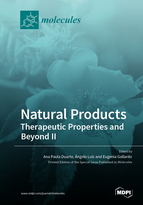Natural Products: Therapeutic Properties and Beyond II
A special issue of Molecules (ISSN 1420-3049). This special issue belongs to the section "Natural Products Chemistry".
Deadline for manuscript submissions: closed (31 May 2022) | Viewed by 30971
Special Issue Editors
Interests: plant extracts; biological activities of natural products; bioaccessibility and bioavailability of phenolic compounds
Special Issues, Collections and Topics in MDPI journals
Interests: plant extracts; essential oils; polyphenols; antioxidant and antimicrobial properties; functional films
Special Issues, Collections and Topics in MDPI journals
2. Pharmaco-Toxicology Laboratory, UBIMedical, University of Beira Interior, Covilhã, Portugal
3. Centro Académico Clínico das Beiras (CACB)—Grupo de Problemas Relacionados com Toxicofilias, Covilhã, Portugal
Interests: toxicology; analytical method development; recreational drugs; natural psychoactive substances; therapeutic drug monitoring; sample preparation; alternative samples; miniaturized extraction procedures
Special Issues, Collections and Topics in MDPI journals
Special Issue Information
Dear colleagues,
Due to the great success of the first Special Issue on Natural Products: Therapeutic Properties and Beyond, it is our pleasure to announce this second edition.
Natural products present a great variety of chemical and structural properties, and in recent years, new developments concerning these compounds have widened the horizon of research applications, aiming at obtaining new agents for human therapy. However, their beneficial effects on human health are far from the only features of these products, as recreational or abusive consumption of certain compounds of natural origin is also alarming.
With this Special Issue, we aim to categorize the state of the art concerning scientific research on natural products, including their applications as compounds of added value to human health.
Presenting a very broad scope, this Special Issue welcomes full papers, short communications, and review articles on, but not limited to, physiologically active compounds (namely from terrestrial or marine plants); secondary metabolites of microorganisms (for instance, antibiotics and mycotoxins); biochemical studies, isolation, structure elucidation, and chemical synthetic pathways of novel compounds of natural origin; pharmacology of naturally occurring compounds; and the development of new detection and quantification methods. Meta-analyses and articles that use bioinformatic tools are welcome.
This issue should serve as a text for academia, or as a reference tool for researchers, particularly those working in the fields of medicinal chemistry, toxicology, phytochemistry, natural product chemistry, and health and industry professionals.
Prof. Dr. Ana Paula Duarte
Dr. Ângelo Luís
Prof. Dr. Eugenia Gallardo
Guest Editors
Manuscript Submission Information
Manuscripts should be submitted online at www.mdpi.com by registering and logging in to this website. Once you are registered, click here to go to the submission form. Manuscripts can be submitted until the deadline. All submissions that pass pre-check are peer-reviewed. Accepted papers will be published continuously in the journal (as soon as accepted) and will be listed together on the special issue website. Research articles, review articles as well as short communications are invited. For planned papers, a title and short abstract (about 100 words) can be sent to the Editorial Office for announcement on this website.
Submitted manuscripts should not have been published previously, nor be under consideration for publication elsewhere (except conference proceedings papers). All manuscripts are thoroughly refereed through a single-blind peer-review process. A guide for authors and other relevant information for submission of manuscripts is available on the Instructions for Authors page. Molecules is an international peer-reviewed open access semimonthly journal published by MDPI.
Please visit the Instructions for Authors page before submitting a manuscript. The Article Processing Charge (APC) for publication in this open access journal is 2700 CHF (Swiss Francs). Submitted papers should be well formatted and use good English. Authors may use MDPI's English editing service prior to publication or during author revisions.
Keywords
- Natural products
- Secondary metabolites
- Drug discovery
- Therapeutic properties
- Recreational use
- Analysis









